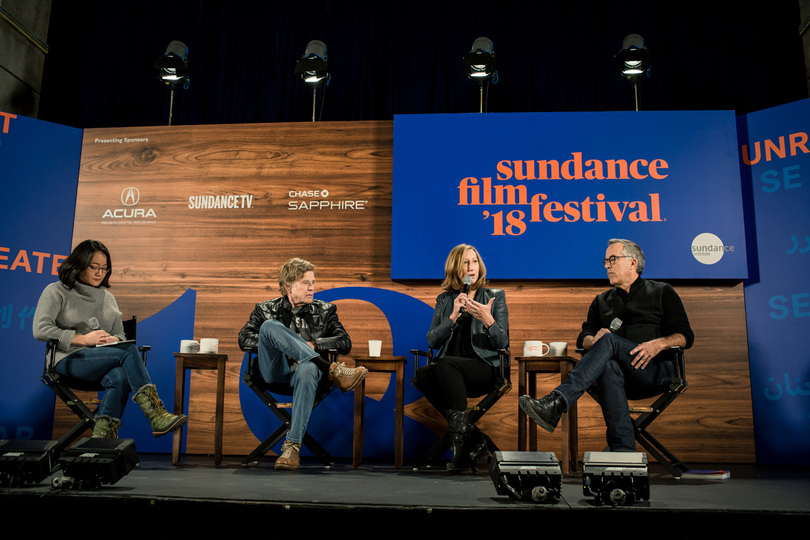Movie columnist Mike O’Connor discusses Sundance Film Festival, this year’s noteworthy entries

Moderator Barbara Chai, Sundance Institute President, Founder Robert Redford, Sundance Institute Executive Director Keri Putnam and Sundance Film Festival Director John Cooper at the Day One Press Conference of the 2018 Sundance Film Festival. Courtesy of Sundance Institute
On Jan. 18, the Sundance Film Festival kicked off in Park City, Utah, marking the 33rd annual gathering of filmmakers, film critics and film fanatics to celebrate the hottest names in independent cinema.
Documentaries make up a large part of this year’s lineup. Climate change is, again, a major theme throughout the new block of flicks, as it was in 2017. The most anticipated documentary of 2018 dealing with this theme is “Anote’s Ark,” which details the imminent fate of a remote island nation at risk from rising sea levels.
With the current climate of Hollywood, a major topic of discussion this year will be the sexual abuse and misconduct carried out by powerful men in the United States. Most notably, “Seeing Allred” follows the story of attorney Gloria Allred and her encounters with Bill Cosby and Donald Trump.
Several other features don’t shy away from politics, either. In 2018 we will see the debut of “On Her Shoulders,” a film about Nadia Murad, a 23-year-old who survived imprisonment by the ISIS militants who murdered her relatives. Others include “RBG,” a study on the life and times of Justice Ruth Bader Ginsburg, and “Our New President,” a look at the story of Donald Trump’s presidential victory told entirely through the lens of Russian propaganda.
Other films of note include “The Catcher Was a Spy,” written by Robert Rodat and starring Paul Rudd; “Yardie,” Idris Elba’s directorial debut set in 1970s Jamaica; and “Wildlife,” starring Jake Gyllenhaal and Carey Mulligan as a struggling couple who move to Montana.
The Sundance Film Festival was founded by actor and director Robert Redford. Redford was one of the leading visionaries in the independent film movement and is perhaps best known for his performance as “The Sundance Kid” in “Butch Cassidy and the Sundance Kid” (1969), from which the Sundance Institute — and by way of that, the Sundance Film Festival — would derive their names. In its first year, then known as the Utah/U.S. Film Festival, it featured an impressive catalog of classic films such as “Deliverance” (1972), “A Streetcar Named Desire” (1951), “Midnight Cowboy” (1969) and “Mean Streets” (1973).
In 1985, creative and administrative control was assumed by Redford’s Sundance Institute. In 1989, the festival would screen Steven Soderbergh’s “Sex, Lies and Videotape,” and the world of independent cinema would never be the same.
The initial temptation after the newfound popularity, according to Redford, was to move in the direction of other film festivals, such as the Festival de Cannes in France. But the director and chairman warned against this path, saying that Sundance would be sacrificing quality for publicity.
In a 2014 interview with The Guardian, Redford expressed his disapproval with the current trends of Sundance. “How can I not be satisfied about a success? But those earlier years felt best,” he said. “They’re taking away some of the textures and qualities that were here that gave it a kind of intimacy. It’s no longer the place it was. I don’t like what’s happened.”
Some of cinema’s most influential works in recent decades have premiered at Sundance, and the steady stream of producers and studio executives with their ticket in one hand and checkbook in another has only strengthened.
Perhaps the film that our friend Mr. Redford will be most excited to see is “Hal.” “Hal” focuses on the story of Hal Ashby, a filmmaker who reaped the benefits of multiple Oscar-winning classics, but soon fell into obscurity when he failed to compromise with major Hollywood studios. In 2018, Redford might appreciate this cautionary tale, and so might you.
Michael O’Connor is a freshman television, radio and film major. His column appears biweekly. He can be reached at moconn03@syr.edu




